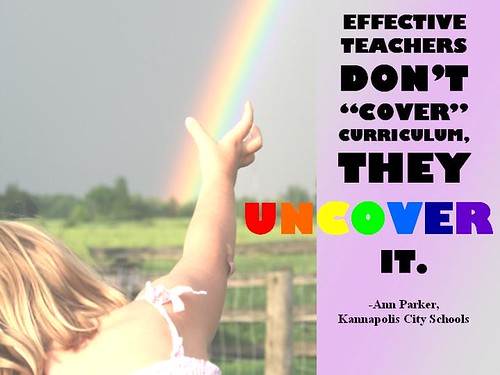In a meeting with middle school ELA teachers in Northern New York State,
the topic of coverage came up with a visceral passion. Because of new
standards, new curriculum requirements, new assessments, and new evaluations, teachers
were feeling the pressure to make sure that they covered everything that might
be on THE TEST. These teachers
participated in several benchmark tests throughout the school year as well as
offered multiple opportunities for the students to demonstrate learning through
more formative assessments that happened often.
They told me that in the last two years of state testing, their students had performed, collectively, at historic lows and that the average level of proficiency was hovering around 25% for both years, despite the fact that they felt as though they covered everything. They described, with pride, how they focused on on-task behaviors and making sure that they systematically got through all of the standards associated with the new curriculum materials and the testing guides put out by New York State.
To summarize, the teachers covered 100%, or as close to 100% of their curriculum through their detailed daily lessons and unit plans that systematically covered the standards. Their students, after participating in these lessons, scored at a level of 25% proficient.
Now, some caveats. Scoring 25% on the one state test is virtually meaningless. It is a standardized test that is designed to quickly measure what a student knows and is able to do at a specific point in time under specific testing conditions. It is a pulse, not a diagnosis. In this case, it is a potential checkpoint of the impact of teaching on student learning and is not the only factor in the discussion with these teachers. Proficiency on tests like this, and perhaps on just about any assessment, is relative to other variables: readability, fatigue, interest, time, hunger, etc.
We can’t necessarily quantify learning with standardized tests in the same way we can’t weigh a student’s brain before and after learning to see if the new knowledge causes a brain weight gain. It’s imperfect science. It’s just a pulse. Is it nice to know the pulse? Yes. Is it the only diagnostic measure a teacher would use as an artifact of learning? Certainly not.
Besides the state tests, these teachers also told me that the benchmark assessments and many of the formative assessments also showed low levels of proficiency though there were moments of bright spots when the students were really excited or interested in the topic or the engaging ways in which a teacher chose to teach.
Based on what these teachers told me, these were the conclusions that I shared with them:
- They need to talk about the standards. Which ones fit together naturally, which ones have priority over others based on several lenses: readiness, endurance, leverage, and yes, the end of course assessment.
- They need to talk about the tests. The tests seem to matter more for teacher evaluation, and, as one Board of Regents’ Member said on CNN, for taxpayer accountability, then they do for actual student performance. If that’s the case, understanding the parameters of the testing lens and having discussions about priorities help them to teach for success no matter the assessment rather than teaching to the test.
- If they teach 100% but the students demonstrate at a 25% level, what would happen if they teach 75% (based on the priorities)? With time and depth, what positive changes would they expect to see in proficiency?
- Giving benchmark assessments and formative assessments, but not using the data to inform future instruction despite the rigidity in their lessons and pacing, is like noticing a kid’s shoelaces are untied and rather than stop and tie them for improved performance, forcing them to run even faster down the track, ignoring the tripping and slipping.
- The detailed lesson plans and coverage mindset is robbing their students of time to think and process, of being creative, of having choices in process and product, and of real learning.
- Learning doesn’t happen because something is taught. Learning happens when something is discovered.
If we are simply covering the curriculum, or letting textbooks or vendor
products divine our practice, how do we really know that students have learned
what we intended for them to learn? Deep learning can’t happen with
micromanaged details, nor can it happen with our insistence upon covering everything.
Perhaps a good essential question to ask might be, “How can we UNCOVER the curriculum?” Or maybe, “How can we be less formulaic and more exploratory in the learning process?” Now that summer is here and many of us have some time to devote to curricular examinations and upgrades, perhaps these two questions would be good to start a discussion with?
Upgrade Your Curriculum now available from ASCD.
Digital
Learning Strategies now available from ASCD.
Ditch the Daily Lesson Plan coming soon...
Join
me and the rest of the Curriculum 21 Faculty for Connect 21 Camp at
Washington's National Harbor Gaylord Hotel from August 6-8, 2015! CLICK
HERE FOR DETAILS!


